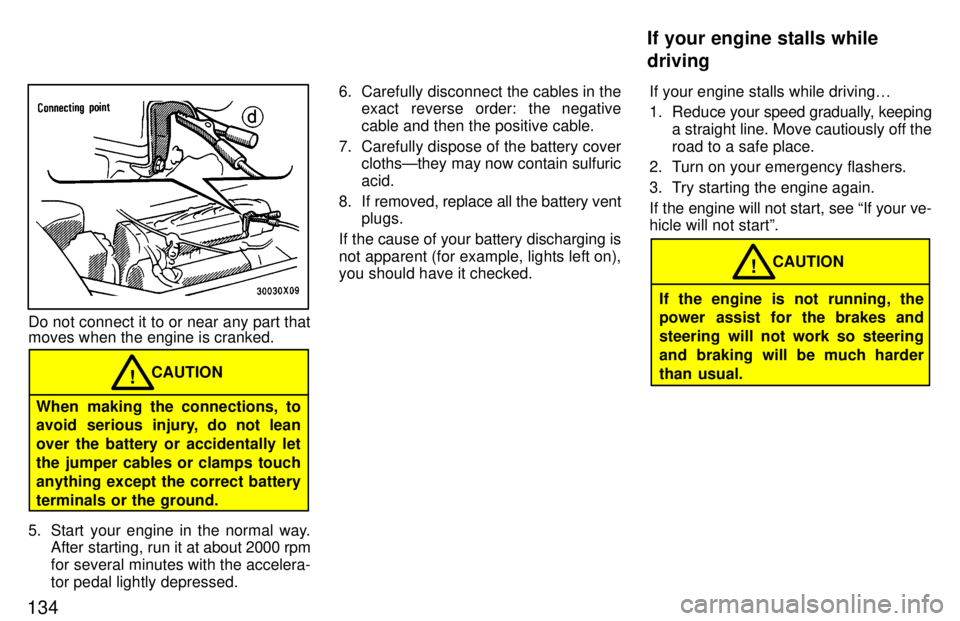1997 TOYOTA RAV4 lights
[x] Cancel search: lightsPage 68 of 198

66
To turn on the personal light, push the
switch. To turn the light off, slightly
push the switch on the opposite side.
The personal light switch has the following positions:
ONºÐKeeps the light on all the time.
DOORºÐTurns the light on when either
front door is opened. The light goes off
when both front doors are closed.The personal lights operate separately
with each outer switch.
To turn on the light, push the switch on
your side. To turn the light off, push the
switch once again.
The center switch has the following posi- tions: DOORºÐTurn both lights on when either
front door is opened. The light goes off
when both front doors are closed.
OFFºÐThe lights are off unless you op- erate either outer switch.To turn on the windshield wipers, move the lever to the desired setting. The key must be in the ONº position.
Lever position
Speed setting
Position 1Intermittent
Position 2Slow
Position 3Fast
To squirt washer fluid, pull the lever to-
ward you and release it.
If the windshield wipers are off, they will
operate a couple of times after the washer
squirts.
Personal lights (without moon roof)
Windshield wipers and washer
Personal light (with moon roof)
Page 96 of 198

95
Seeking
In the seek mode, the radio finds and plays the next station up or down the sta- tion band.
To seek a station, push and hold the
~º or
! º side of TUNEº until you hear a beep.
Do this again to find another station.
To ensure the correct audio system
operation:
�Be careful not to spill beveragesover the audio system.
�Do not put anything other than acassette tape into the slot.
NOTICE
ILLUMINATION CONTROL LOGIC
On some audio-units, when the instru-
ment panel lights are on, the letters on op-
erable buttons of the mode in current use
light up together with the mode selection and eject buttons. RADIO RECEPTION
Usually, a problem with radio reception
does not mean there is a problem with
your radio-it is just the normal result of
conditions outside the vehicle.
For example, nearby buildings and terrain
can interfere with FM reception. Power
lines or telephone wires can interfere with
AM signals. And of course, radio signals
have a limited range, and the farther youare from a station, the weaker its signal
will be. In addition, reception conditions
change constantly as your vehicle moves. Here are some common reception prob- lems
that probably do not indicate a prob-
lem with your radio: FM
Fading and drifing stationsÐGenerally,
the effective range of FM is about 40 km
(25 miles). Once outside this range, you
may notice fading and drifting, which in- crease with the distance from the radio
transmitter. They are often accompanied by distortion.
Multi-pathÐFM signals are reflective,
making it possible for two signals to reach
your antenna at the same time. If this hap-pens, the signals will cancel each other
out, causing a momentary flutter or loss of
reception.
Static and flutteringÐThese occur when
signals are blocked by buildings, trees, or other large objects. Increasing the bass
level may reduce static and fluttering.
Station swappingÐIf the FM signal you are listening to is interrupted or weak-
ened, and there is another strong station
nearby on the FM band, your radio may
tune in the second station until the original
signal can be picked up again.
ÐCar audio system operating hints
Page 104 of 198

Part 1Clock
103
OPERATION OF INSTRUMENTS ANDCONTROLSÐ
Chapter 1-8 Other equipment �
Clock
�Cigarette lighter and ashtray
�Glovebox
�Auxiliary box
�Floor mat
The digital clock indicates the time.
The key must be in the ACCº or ONº position.
To reset the hour: Push the ºHº button.
To reset the minutes: Push the Mº button.
If quick adjustment to a full hour is de- sired, push the :00º button.
For example, if the :00º button is de-
pressed when the time is between
1:01Ð1:29, the time will change to 1:00.
If the time is between 1:30Ð1:59, the time
will change to 2:00.
Once the electrical power source has
been disconnected from the clock, the
time is automatically set to 1:00 (oneo'clock). When the instrument panel lights are turned on, the brightness of the time indi-cation will be reduced.
Page 120 of 198

Part 3How to start the engineÐ
(a) Before cranking
Before starting the engine
11 9
STARTING AND DRIVING �
Before starting the engine
�How to start the engine
�Tips for driving in various conditions
�Off-road driving precautions
�Winter driving tips
�Trailer towing
�How to save fuel and make your
vehicle last longer, too
1. Check
the area around the vehicle be-
fore entering it.
2. Adjust seat position, seatback angle, head restraint height and steering
wheel angle.
3. Adjust inside and outside rear view mirrors.
4. Lock all doors.
5. Fasten seat belts. 1. Apply the parking brake firmly.
2. Turn off unnecessary lights and acces-
sories.
3. Manual transmission: Press the
clutch pedal to the floor and shift the
transmission into neutral. Hold theclutch pedal to the floor until the engine
is started. A starter safety device willprevent the starter from operating if
the clutch pedal is not fully depressed.
Automatic transmission: Put the se-
lector lever in Pº. If you need to restart
the engine while the vehicle is moving, put the selector lever in Nº. A starter
safety device will prevent the starter
from operating if the selector lever is in
any drive position.
4. Automatic transmission only: De-
press the brake pedal and hold it to the
floor until driving off.
Page 127 of 198

126
TIRES �
Ensure that your vehicle's tires are
properly inflated. See Chapter 7-2 forinstructions.
� The trailer tires should be inflated to
the pressure recommended by the
trailer manufacturer in respect to the
total trailer weight.
TRAILER LIGHTS � Trailer lights must comply with federal,
state/provincial and local regulations. See your local recreational vehicle
dealer or rental agency for the correcttype of wiring and relays for your trail-
er. Check for correct operation of the
turn signals and stop lights each time
you hitch up. Direct splicing may dam-
age your vehicle's electrical system
and cause a malfunction of your lights.
BREAK-IN SCHEDULE � Toyota recommends that you do not
tow a trailer with a new vehicle or a ve-
hicle with any new power train compo-
nent (engine, transmission, differen-tial, wheel bearing, etc.) for the first
800 km (500 miles) of driving. MAINTENANCE �
If you tow a trailer, your vehicle will re-
quire more frequent maintenance due
to the additional load. For this informa-
tion, please refer to the scheduled
maintenance information in the Own-
er 's Manual Supplement/Maintenance Scheduleº.
� Retighten all fixing bolts of the towing
ball and bracket after approximately
1000 km (600 miles) of trailer driving.
PRE-T OWING SAFETY CHECK � Check that your vehicle remains level
when a loaded or unloaded trailer is
hitched. Do not drive if the vehicle has
an abnormal nose-up or nose-down
condition, and check for improper
tongue load, overload, worn suspen-
sion or other possible causes.
� Make sure the trailer cargo is securely
loaded so that it cannot shift.
� Check that your rear view mirrors con-
form to any applicable federal, state/
provincial or local regulation. If not,
install the rear view mirrors required
for towing purpose. TRAILER TOWING TIPS
When towing a trailer, your vehicle will
handle differently than when not tow-ing. The three main causes of vehicle
trailer accidents are driver error, ex-
cessive speed and improper trailer
loading.
Keep these in mind when tow-
ing: � Before starting out, check operation of
the lights and all vehicle-trailer con-
nections. After driving a short dis-
tance, stop and recheck the lights and
connections. Before actually towing a
trailer, practice turning, stopping and
backing with a trailer in an area away
from traffic until you learn the feel.
� Because stopping distance may be in-
creased, vehicle-to-vehicle distance
should be increased when towing a
trailer. For each 16 km/h (10 mph) ofspeed, allow at least one vehicle and
trailer length between you and the ve-
hicle ahead. Avoid sudden braking as you may skid, resulting in jackknifing and loss of control This is especially
true on wet or slippery surfaces.
Page 130 of 198

129
�
Avoid continuous speeding up and
slowing down. Stop-and-go driving
wastes fuel.
� Avoid unnecessary stopping and braking. Maintain a steady pace. Try
to time the traffic signals so you only
need to stop as little as possible or take
advantage of through streets to avoid
traffic lights. Keep a proper distance
from other vehicles to avoid suddenbraking. This will also reduce wear onyour brakes.
� Avoid heavy traffic or traffic jams
whenever possible.
� Do not rest your foot on the clutch
or brake pedal. This causes needless
wear, overheating and poor fuel econ-
omy.
� Maintain a moderate speed on highways. The faster you drive, the
greater the fuel consumption. By re-
ducing your speed, you will cut down
on fuel consumption. �
Keep the front wheels in proper alignment. Avoid hitting the curb and
slow down on rough roads. Improper
alignment not only causes faster tire
wear but also puts an extra load on the
engine, which, in turn, wastes fuel.
� Keep the bottom of your vehicle
free from mud, etc. This not only
lessens weight but also helps prevent corrosion.
� Keep your vehicle tuned-up and in
top shape. A dirty air cleaner, improp-
er valve clearance, dirty plugs, dirty oil
and grease, brakes not adjusted, etc.
all lower engine performance and con-
tribute to poor fuel economy. For lon-
ger life of all parts and lower operating
costs, keep all maintenance work on
schedule, and if you often drive undersevere conditions, see that your ve-
hicle receives more frequent mainte-
nance (For scheduled maintenance in-
formation, please refer to the separate
Owner 's Manual Supplement/Main-
tenance Scheduleº).
CAUTION!
Never turn off the engine to coast
down hills. Your power steering and
brake booster will not function with-
out the engine running. Also, the
emission control system operates
properly only when the engine is run-
ning.
Page 133 of 198

133
JUMP STARTING PROCEDURE
1. If the booster battery is installed in
another vehicle, make sure the ve-
hicles are not touching. T urn off all un-
necessary lights and accessories.
2. If required, remove all the vent plugs from the booster and discharged bat-
teries. Lay a cloth over the open vents
on the batteries. (This helps reduce
the explosion hazard, personal injuries
and burns.)
3. If the engine in the vehicle with the booster battery is not running, start it
and let it run for a few minutes. During
jump starting, run the engine at about
2000 rpm with the accelerator pedal
lightly depressed.
4. Make the cable connection in the ordera, b, c, d.
a. Connect the clamp of the positive(red) jumper cable to the positive (+)
terminal on the discharged battery.
b. Connect the clamp at the other end
of the positive (red) jumper cable to the
positive (+) terminal on the booster
battery.c. Connect the clamp of the negative
(black) cable to the negative (-) termi-
nal on the booster battery.
d. Connect the clamp at the other end
of the negative (black) jumper cable to
a solid, stationary, unpainted, metallic
point of the ve hicle with the discharged
battery.The recommended connecting point is
shown in the following illustration:
Page 134 of 198

134
Do not connect it to or near any part that moves when the engine is cranked.
When making the connections, to
avoid serious injury, do not lean over the battery or accidentally let
the jumper cables or clamps touchanything except the correct battery
terminals or the ground.CAUTION
!
5. Start your engine in the normal way. After starting, run it at about 2000 rpm
for several minutes with the accelera- tor pedal lightly depressed. 6. Carefully disconnect the cables in the
exact reverse order: the negative
cable and then the positive cable.
7. Carefully dispose of the battery cover clothsÐthey may now contain sulfuricacid.
8. If removed, replace all the battery vent plugs.
If the cause of your battery discharging is
not apparent (for example, lights left on), you should have it checked. If your engine stalls while driving
0
1. Reduce your speed gradually, keeping
a straight line. Move cautiously off the
road to a safe place.
2. Turn on your emergency flashers.
3. Try starting the engine again.
If the engine will not start, see If your ve-
hicle will not startº.
If the engine is not running, the
power assist for the brakes and
steering will not work so steering
and braking will be much harder
than usual. CAUTION
!
If your engine stalls while driving